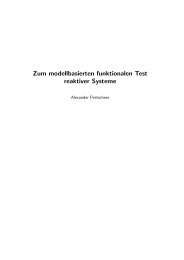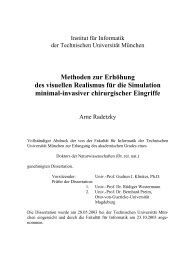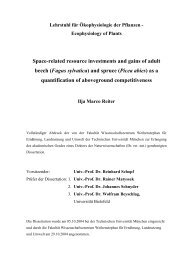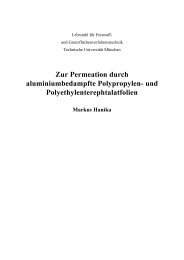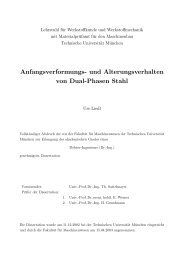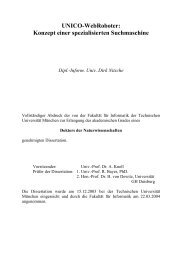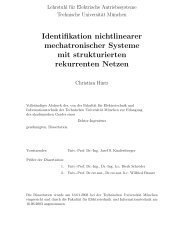Topologically Defined Neuronal Networks Controlled by Silicon Chips
Topologically Defined Neuronal Networks Controlled by Silicon Chips
Topologically Defined Neuronal Networks Controlled by Silicon Chips
Create successful ePaper yourself
Turn your PDF publications into a flip-book with our unique Google optimized e-Paper software.
CHAPTER 2. NETWORKS OF DEFINED TOPOGRAPHY<br />
Figure 2.1: Four types of mechanisms contribute<br />
to guiding growth-cones: contact attraction,<br />
chemoattraction, contact repulsion<br />
and chemorepulsion. Individual growthcones<br />
might be ‘pushed’ from behind <strong>by</strong> a<br />
chemorepellant (red), ’pulled’ from afar <strong>by</strong> a<br />
chemoattractant (green), and ’hemmed’ in <strong>by</strong><br />
attractive (grey) and repulsive (yellow) local<br />
cues; from [110].<br />
Directional cues are either attractive or repulsive, long-range or short-range. The long-range guidance<br />
mechanism, called chemotaxis, is based on gradients of diffusible, soluble molecules, whereas the<br />
short-range contact-mediated mechanism is mediated <strong>by</strong> tissue-bound, non-diffusible molecules. Fig.<br />
2.1 depicts the four forces guiding growth-cones: contact attraction, chemoattraction, contact repulsion<br />
and chemorepulsion, and lists examples of ligands governing these mechanisms. Some guidance<br />
molecules are not exclusively attractive or repulsive but rather bifunctional, depending on their concentration,<br />
type of receptor and presence of other molecules. In vivo, neuronal outgrowth is generally<br />
controlled <strong>by</strong> several cues acting simultaneously and synergistically, e.g. the growth-cone is repelled<br />
from its origin <strong>by</strong> one ligand and attracted to the target tissue <strong>by</strong> another.<br />
Besides these ligand-mediated cues, axonal outgrowth is further influenced <strong>by</strong> trophic factors that are<br />
needed for survival and growth as well as <strong>by</strong> adhesion molecules providing adhesive surfaces for the<br />
growth-cone.<br />
Although many directional signals are present in vivo, in vitro studies revealed that a single ligand is<br />
often sufficient for controlling neuronal outgrowth. These studies set the stage for the design of defined<br />
neuronal nets.<br />
2.1.2 Chemical patterns<br />
Tracks of substrate bound molecules that are either attractive or repulsive to growth-cones (haptotaxis)<br />
are the most widely used technique for growth-cone guidance in vitro. In contrast to gradients of soluble<br />
molecules, they are easy to produce and can be kept in culture medium for a week or more without<br />
loosing their potency.<br />
Two major issues are raised with chemical patterns: what molecules are best and how to deposit them<br />
on the substrate? The vast body of literature on this subject is summarized <strong>by</strong> several comprehensive<br />
reviews [5, 22, 30, 52, 54].<br />
In an early experiment, P.C. Letourneau deposited areas of palladium onto different substrates <strong>by</strong> evaporation<br />
through EM-grids as masks [61]. Growth-cones from chick sensory ganglia neurons preferentially<br />
elongated on the more adhesive areas; for Pd on glass petri dishes they stayed on the Pd, while if<br />
polyornithine-coated dishes were used they preferred the Pd-free areas.<br />
Since then, many chemicals have been tested for patterns controlling cell adhesion and neuronal outgrowth.<br />
Among them are adhesive proteins like extracellular matrix protein (ECM) [35], laminin [42],<br />
growth factors [81] and nonadhesive proteins like albumin [21]. Artificial growth-promoting molecules<br />
such as poly-L-lysine and poly-D-lysine [8], and inhibitors such as poly ethylene glycol (PEG) are also<br />
common [121]. All these substances are only physisorbed to the substrate. Due to the weak binding<br />
6


